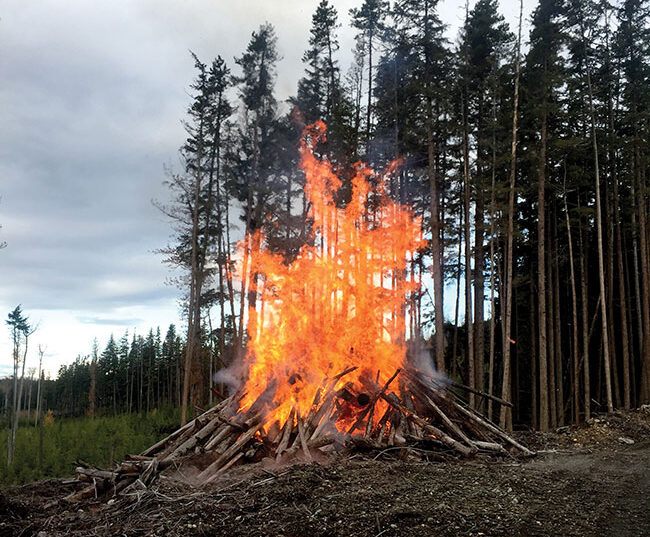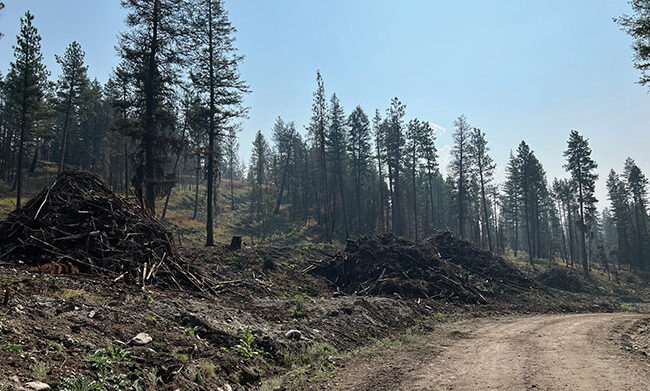
The burning question: Addressing harvest residue management in B.C.
February 15, 2023
By Eric Nance, Dominik Roeser, Carly A. Phillips, Caren C. Dymond and Werner A. Kurz
Researchers identify potential management alternatives to slash pile burning that would make better use of residual fibre across a range of operational conditions in B.C.
 Common forest industry practice in B.C. is to pile and open burn harvest residues. Photo by Eric Nance.
Common forest industry practice in B.C. is to pile and open burn harvest residues. Photo by Eric Nance. The management of harvest residues has long been a challenge for British Columbian operators who are tasked with balancing wildfire fuel loading, planting space, and financial, operational, and regulatory constraints. Now, society’s concerns about carbon emissions have been added to that list and practices will have to change.
Common practice in the industry today includes either leaving residues piled in the cutting area to decompose or open-burning residues with the practice of slash-pile burning (SPB). While these low-cost treatments may meet the minimum management requirements, more needs to be done to improve their use and management moving forward.
SPB is a considerable emissions source, producing an array of harmful greenhouse gases (GHG) and particulate matter, and accelerating the release of carbon to the atmosphere. These factors enhance climate change and have negative human health impacts. In some areas, open burning of residues can also have negative impacts on ecological functions, such as future stand productivity and small mammal habitat. Furthermore, harvest residual fibre could be flowing to the bioeconomy, where it can be used for value-added products or bioenergy that can displace more carbon intensive alternatives.

Common practice in the industry today includes either leaving residues piled in the cutting area to decompose or open-burning residues with the practice of slash-pile burning. Photo by Dominik Roeser
There are potential management alternatives to SPB that may serve to better use residual fibre across a range of operational conditions. Considering current B.C. and Canadian climate targets, transitioning away from SPB and towards more sustainable alternatives will help mitigate GHG emissions and improve forest stewardship.
Alternatives
Redistribution after whole-tree harvesting: Leaving residues dispersed across the cutting area can increase soil carbon stocks, improve soil nutrients, provide shaded planting spots and wildlife habitat, and reduce soil erosion. Residues can be left whole or can first be masticated with a chipper, grinder, or chopper-roller before being redistributed from the roadside or landings. While retaining residual fibre can improve site level tree growth and stand productivity, this alternative should only be employed where planting efforts will not be hindered, and wildfire fuel loading will not exceed acceptable levels.
Brush-mats and road amendments: Brush-mats made from residual branches, tops, and small round wood can reduce soil rutting and compaction from forest machines, mitigating the associated increases in water runoff and sediment transport. Furthermore, residues piled on trails are compressed, promoting decomposition and retaining nutrients (in particular nitrogen) in the cutting area, which might otherwise be lost during SPB. While brush-mats are mostly associated with stem-only and cut-to-length harvesting operations, this technique can also be employed during conventional whole-tree harvesting, whereby primary transportation machines (skidders, etc.) bring residues from roadside piles back into the cutblock, applying them to main trails during return trips.
The use of mulched right-of-way harvesting residues for surfacing on temporary roads can reduce road failure from rutting, when compared with standard soil-surfaced roads. Using residues in this way can have less environmental impact and be less cost prohibitive than upgraded gravel surfacing.
Left decked in oriented piles: If residues need to be left in the cutting area, pre-sorting residues during processing to separate and deck round-wood into oriented piles can be a better alternative to leaving them piled in “hay-stacks” or SPB. Preliminary studies by FPInnovations have demonstrated that oriented decking can reduce the wildfire risk of the pile, provides the opportunity for secondary users to easily access the decked wood if future markets emerge, and does not require significant incremental cost to operators.
Mobile burning containers: If wildfire fuel loading must be reduced, but markets don’t exist to use the residues, employment of mobile burning units (air curtain burner, etc.) are an effective alternative to SPB. Controlled burning in these units can reduce emissions (in particular methane) with higher efficiency combustion, while creating biochar and ash byproducts which store carbon and can be redistributed as soil amendments. Additionally, the use of these units nearly eliminates the risk of fire escape during the treatment.
Liquid and solid biofuels: Certain types of logging residue can be a valuable feedstock for liquid and solid biofuels, including: pellets, briquettes, hog fuel, liquid transport fuels, and others. Using residues for liquid or solid fuel provides emissions benefits when they are used to displace fossil alternatives like coal and gasoline. Initial capital investment and procurement costs of feedstock are likely to be prohibitive in many B.C. harvest conditions. Though small-scale, mobile conversion systems address some of these costs and are a promising alternative to centralized processing facilities.
Other products: Residues can also be used to create novel or non-commodity wood products in B.C. Research has expanded the use of wood fibre to include products like bio-based polymeric materials, textiles, building insulation, and many more. While residues can be used as feedstock for these products, current demand is relatively low. What is more practical in the short term, is use of low quality or small-dimension roundwood for small-scale manufacturing of products like rail ties, fenceposts, firewood, or finger-joined boards.
A path forward
Residue management is complex and has interactions with many environmental (e.g., fire risk) and operational (e.g., transportation distances) factors, creating a system that is highly dependent on site- level conditions – there is no one-size-fits-all solution. Where possible, residues should be used in the bioeconomy, whether that be for energy production, or small-scale products manufacturing. These opportunities can provide GHG emissions benefits relative to the business-as-usual practices, increase timber supply, and provide job opportunities for British Columbians.

Residue management is complex and interacts with many environmental and operational factors that are site specific. Photo by Dominik Roeser.
When diverting residues to the bioeconomy is not practical, other treatments can reduce emissions and better support forest ecosystems when compared with SPB. Importantly, partial solutions can be implemented.
More responsible management of residues will, however, come at a higher cost than the current leave-it or burn-it practices. Transportation and processing costs, coupled with relatively low market values for residual fibre, can limit opportunities for operators and investors. We don’t expect that forest managers and operators will take on higher cost treatments voluntarily, and therefore solutions are needed that reduce and share these costs of fire risk mitigation and emissions reductions.
Possibly the most important step we can take towards more responsible management of harvest residues is a shift of our mindsets from the view that residues are a waste byproduct of harvesting. Residues are a component of the fibre profile alongside the others, which should be managed with as much care and stewardship as the high-value logs that B.C. is known for. The more we start planning for residues as we lay out our cutblocks, and not as an afterthought once the logs are gone, the more operational efficiencies we will be able to command, the lower our costs will be for treatment and processing, and the smaller our emissions will be in the forest.
The pool of residual fibre is massive in our province, and any incremental shift we can make towards better future management could have a truly meaningful impact on our forests and the growing bioeconomy.
We gratefully acknowledge the financial support of the Government of Canada through the Low Carbon Economy Leadership Fund and Province of British Columbia through the Ministry of Forests, Lands, Natural Resource Operations and Rural Development, as well as the contributions and support of the Pacific Institute for Climate Solutions’ Wildfire and Carbon project.
Eric Nance, master of science, forest operations and management at the University of British Columbia (UBC). Dominik Roeser is an associate professor forest operations, UBC. Carly A Phillips is a researcher-in-residence at the Pacific Institute for Climate Solutions. Caren C. Dymond is a forest carbon and climate change research scientist with the Ministry of Forests, Government of British Columbia. Werner A. Kurz is a senior research scientist with Natural Resources Canada, Canadian Forest Service.
Print this page